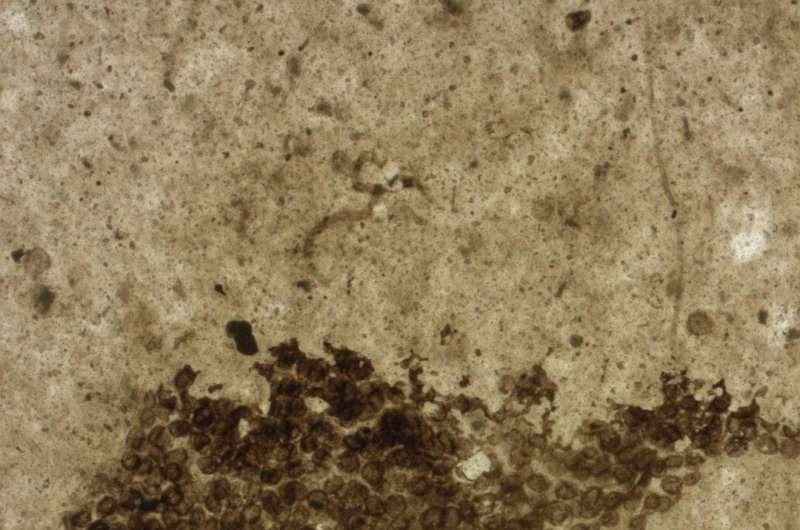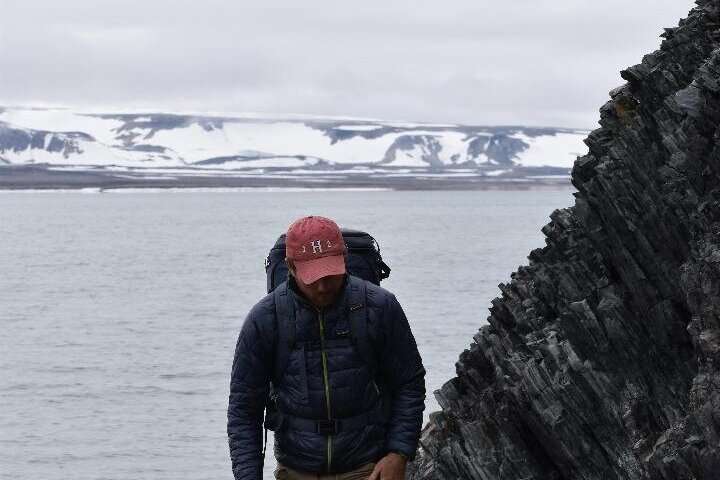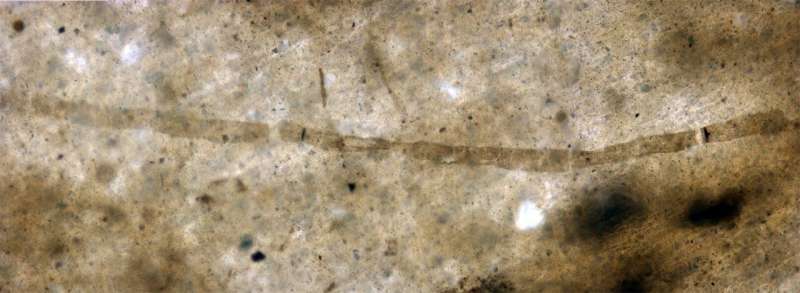Fossilized Ostiana – possibly an ancient bacteria or algae – is visible in this clay sample from Arctic Canada. An individual cell is ~12 µm. Credit: University of Oxford/The Royal Society.
Molecular clock dates for the first animals to walk the Earth don't match the fossil record. Comparing the disparate DNA of two different species and extrapolating how long it would take for them to mutate from a common ancestor suggests animals existed 833-650 million years ago, but the oldest animal fossils discovered so far only date back 580 million years. One explanation is shortcomings in the fossil record—animals did exist, but the rocks and environment were not suitable for fossilization until only 580 million years ago. Now, energy dispersive X-ray spectroscopy and high-resolution infrared spectroscopy have identified the minerals in the mudstones around ancient microfossils, giving insights into their formation suggesting that the right conditions for fossilization existed long before the first animal fossils found so far began to form. The results might also hint at how best to look for evidence of life on Mars.
Animals are relatively recent developments on Earth, predated by around 3.5 to 4 billion years of microbes. "Then, just before the last 500 million years, things suddenly get big, and we get animals for the first time," says Ross Anderson, a researcher in Earth Science at the University of Oxford in the U.K. His efforts to understand these events led him to look for the fossils of microscopic organisms more than 500 million years old that predate this "Cambrian explosion" of larger life forms.
For a long time, experts had assumed no record existed of life before the Cambrian explosion. The discovery in the 1950s of "microfossils" predating larger fossils in a stretch of flint in Canada—the Gunflint chert—prompted the hunt for more microfossils. The preservation processes in cherts and phosphates are well understood, but it turned out that the vast majority of microfossils were found in mudstone, and their formation processes were still unclear, as were the reasons why some mudstones harbored microfossils while others didn't. "We wondered, 'is there a chemistry of these mudstones that is quite precise and would be characteristic of the rocks where we will find the fossils?'" says Ross.
Ross Anderson hunting for fossils in Svalbard, Norway. Credit: Yale University/Alexie Millikin
Kaolinite clues
Fossils of larger animals have also been found in younger mudstones, and these include animals that lack hard skeletons or shells, which are resistant to decay. The discovery of several of these fossils in a stretch of stone in Canada named the Burgess Shale spawned a number of hypotheses as to the processes that form these larger fossils. One theory is that these fossils form in mudstones through a polymerization process that resembles the tanning of leather. Clay minerals in the mudstone bond with the organic matter of the dead animal and polymerize, rendering its soft tissues more resistant to decay. But the bacteria and algae preserved in microfossils are made of different organic materials, so it was doubtful the same processes would apply.
A few years ago, Anderson and his colleagues had experimented with growing the bacteria that cause decay in different mudstone substances. They found that the clay mineral kaolinite—an aluminosilicate—inhibited the bacteria's growth, which could also help to preserve dead animals. While information on the mineralogy around fossils of large animals in mudstone is far from complete, what is known supported the notion that kaolinite played a role in their preservation and might even be involved in the polymerization process. Anderson and his colleagues wondered whether kaolinite might be present in the mudstones harboring microfossils, helping to preserve these microorganisms, too. The challenge was to identify the minerals directly adjacent to the cell wall in these tiny, rare microfossils to see if they were preserved by the same processes.
Fossilized Proterocladus — an ancient, seaweed-like organism — is visible in this clay sample from Svalbard, Norway. Filament width is ~15 µm. Credit: University of Oxford/The Royal Society.
By cutting microscopic slices across the rock layer harboring the microfossil and then a vertical section through the microfossil, they were able to distinguish a halo of mineral a few micrometers thick around the microfossil. From energy-dispersive X-ray spectra, they were able to identify that aluminum was present in the halo, but they could not confirm the exact mineral. Infrared spectral data gives information on how molecules in the sample might vibrate or otherwise respond to incident infrared radiation, giving the exact identity of the mineral. However, the spectra of different clays are very similar, and high-resolution spectra and hence a high signal are required to tell them apart. For this, the researchers took them to the synchrotron at Diamond Light Source, where the high-resolution infrared spectra confirmed the halo was kaolinite.
Halo implications
The results suggest the same processes preserved pre-Cambrian microbes as later larger animals. "So the fact that there are no animals in the 800-million-year-old rocks, even though they've got the same type of preservation—all you find there are bacteria or the algae analyzed—that would suggest that animals really haven't evolved at that time," says Anderson.
In addition, the results direct efforts to find fossils of early life to tropical regions, where there is more kaolinite. It may also give pointers for signs of life further afield. Since the kaolinite preservation process applies to such a broad range of organisms, including microorganisms, it seems a promising line of enquiry in the hunt for fossilized extraterrestrial life, which like life on Earth for the first 3.5 to 4 billion years, may have been microbial, too. "If life was likely microbial and we want to look for its vestiges on Mars, then we better understand how to look for fossilized microorganisms," says Anderson.
More information: Ross P. Anderson et al. Aluminosilicate haloes preserve complex life approximately 800 million years ago, Interface Focus (2020). DOI: 10.1098/rsfs.2020.0011
© 2020 Science X Network


























